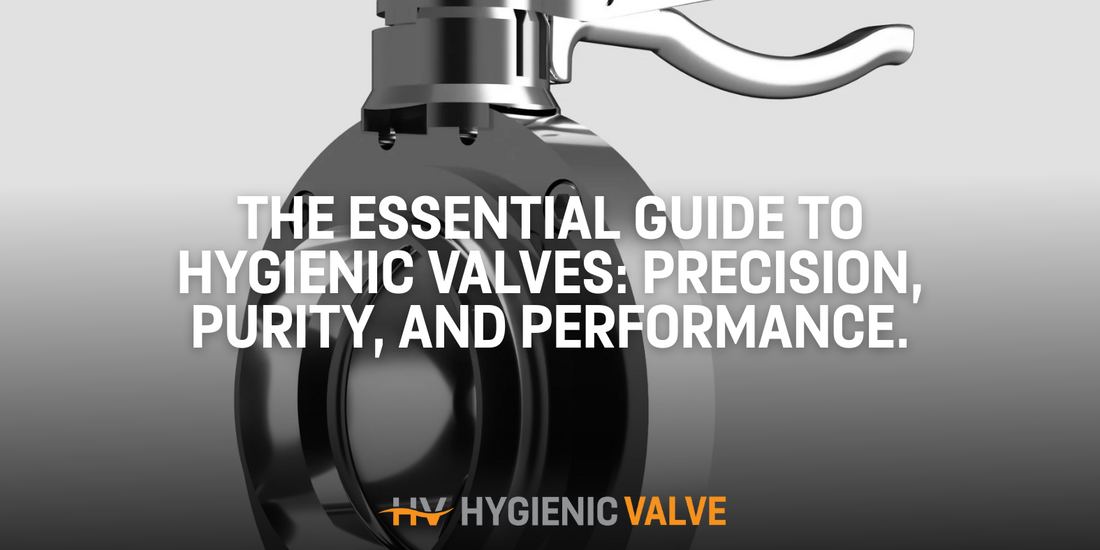
The Essential Guide to Hygienic Valves: Precision, Purity, and Performance
Share
The Essential Guide to Hygienic Valves: Precision, Purity, and Performance
Key Points:
- Designed to prevent contamination in clean environments
- Common in food, beverage, pharmaceutical, and cosmetic industries
- Made from high-grade stainless steel for durability and hygiene
- Compatible with CIP (Clean-in-Place) and SIP (Sterilise-in-Place)
- Available in butterfly, ball, diaphragm, and seat valve designs
- Built for temperature and pressure resilience in critical systems
What Exactly are Hygienic Valves?
Hygienic valves play a critical role in sanitary processing systems, where cleanliness, control, and contamination prevention are non-negotiable. These valves are specially engineered to meet the stringent requirements of industries like food and beverage, pharmaceuticals, and cosmetics. Built with high-quality stainless steel and polished to a smooth, crevice-free finish, hygienic valves ensure sterile conditions are maintained throughout every process cycle.
A hygienic valve is more than just a flow control component—it's a gatekeeper of product integrity. With internal surfaces designed to eliminate dead spaces and allow full drainage, these valves reduce the risk of bacterial growth and product contamination. Many hygienic valves support CIP (Clean-in-Place) and SIP (Sterilise-in-Place) protocols, ensuring they can be cleaned and sterilised without disassembly, maximising uptime and production efficiency.
Butterfly valves are one of the most popular hygienic valve types due to their compact design and quick, quarter-turn operation. However, other variants like diaphragm valves and ball valves are also widely used depending on pressure requirements and product viscosity. Whether you’re bottling dairy, formulating medicines, or producing high-end cosmetics, selecting the right hygienic valve is essential to maintaining compliance and product quality.
Why Hygienic Valves Are Essential:
Hygienic valves are specifically designed for systems where hygiene, product purity, and ease of cleaning are vital. They help companies meet regulatory standards such as FDA, EHEDG, and 3-A Sanitary. The use of stainless steel 304 or 316L, along with options for PTFE or EPDM seals, ensures chemical resistance and longevity, even under aggressive cleaning regimes. From large-scale dairy processing to small-batch pharmaceutical manufacturing, a hygienic valve ensures that fluid control is both efficient and contamination-free.
Moreover, modern hygienic valves are designed with modularity in mind—supporting manual or automatic operation via pneumatic or electric actuators. This allows for flexibility across different production lines and integration with automated control systems for enhanced productivity and process monitoring.
FAQs about Hygienic Valves
1. What is a hygienic valve?
A hygienic valve is a flow control component used in clean environments to maintain sanitary conditions and prevent contamination.
2. Where are hygienic valves used?
Commonly found in food, beverage, pharmaceutical, cosmetic, and biotech industries where sterility and cleanliness are essential.
3. What materials are hygienic valves made from?
Typically made from stainless steel 304 or 316L with sanitary-grade seals such as EPDM, PTFE, or silicone.
4. What types of hygienic valves are available?
Butterfly valves, diaphragm valves, ball valves, and seat valves are the most common types used in hygienic applications.
5. Are hygienic valves compatible with CIP and SIP?
Yes, most hygienic valves are designed to be CIP and SIP compatible to ensure easy cleaning without disassembly.
6. What standards do hygienic valves meet?
Most hygienic valves conform to international standards like FDA, EHEDG, and 3-A Sanitary for hygienic process equipment.
7. How do hygienic butterfly valves work?
They operate with a quarter-turn mechanism to open or close the valve disc, offering quick shutoff and reliable flow control.
8. Do hygienic valves require special installation?
Yes, they typically require clamp or weld-end connections and must be installed with proper alignment to prevent contamination.
9. Can hygienic valves handle high pressure?
Some types, such as hygienic ball valves or seat valves, are designed to withstand higher pressures than butterfly or diaphragm valves.
10. What size range is available for hygienic valves?
Hygienic valves are available in a wide range of sizes, typically from ½” up to 6” depending on the type and application.
11. How often should hygienic valves be serviced?
Regular inspections and servicing depend on the application, but CIP/SIP compatibility helps maintain cleanliness with minimal maintenance.
12. Are actuated hygienic valves available?
Yes, hygienic valves can be fitted with electric or pneumatic actuators for automated control within cleanroom and sterile environments.
